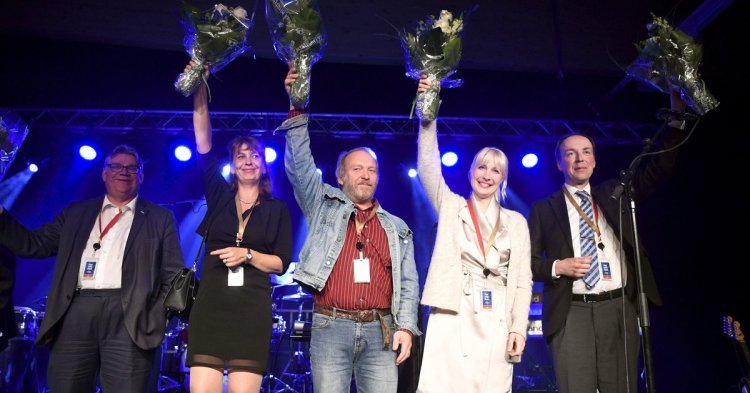What happened in Jyväskylä?
At the Finns Party conference in Jyväskylä, Jussi Halla-aho was elected as the leader of the party on Saturday, June 10. Timo Soini, the longstanding leader of the party and the current Foreign Minister, didn’t stand to be re-elected. Sampo Terho, the minister of European affairs, was regarded as the favoured candidate of the party establishment, while Halla-aho was the favourite of the wing known for its “sour” attitude towards immigration. Halla-aho trailed in polls throughout the spring, but his support had an upward trajectory. At the conference, he claimed victory by a handsome margin.
Prior to the conference, Terho and Halla-aho professed that their views on core issues such as immigration were not vastly different. After his election, too, Halla-aho reiterated his commitment to the government platform.
However, of the two, Halla-aho is clearly the more toxic figure in Finnish politics, not least because of the inflammatory statements he has made in the past years in his blog and which he has failed to denounce. He was convicted of ethnic agitation in 2012 for claiming that Islam is a “paedophilic religion” and that “paedophilia is Allah’s will”. He has also, inter alia, stated that violence is an underappreciated means to resolve conflict, rejected the concept of fundamental equality between human beings in favour of an “instrumental” approach, and expressed his wish that women of the green left be particularly victimised by the inevitable increase in rape incidents brought about by immigration.
The three vice-chairs of the party, elected at the conference, all represented the same wing of the party. In the aftermath of the meeting, some commentators pointed out that a recommendation on Halla-aho’s part to pick out a politician of the more moderate wing of the party (such as Defence Minister Jussi Niinistö) could have alleviated the rift among the party. As things stand, no handouts were given to the wing that occupied the Finns Party’s ministerial posts.
Cabinet in crisis
On Monday, June 12, Prime Minister Juha Sipilä of the Centre Party, and Petteri Orpo, Minister of Finance and the leader of the centre-right National Coalition Party, announced that there was no scope for continued cooperation within the coalition with the Finns Party, which they stated had become an entirely different party over the course of the weekend. Excessive divergence in fundamental values and, interestingly, differences in the parties’ outlook on European integration, were cited as reasons. The Swedish People’s Party and the conservative Christian Democrats were tipped to replace the Finns Party in government.
The following day, 20 of the 37 MPs of the Finns Party left the party’s parliamentary group to establish a parliamentary group called “New Alternative”. The group, which represents the more moderate faction of the Finns Party, comprises each of the cabinet ministers for the party, including Timo Soini who only days earlier had disparaged the idea that he should quit a party whose founding member he is. The members of the group were expelled from the Finns Party.
Although the government is weakened, the New Alternative group is large enough to guarantee a continued parliamentary majority for the coalition. As Prime Minister Sipilä heard about the establishment of the new group on his way to the President’s residence to deliver his request to dismantle the cabinet, he turned around and subsequently burned the letter. The dissolution of the cabinet was averted, but it was a matter of minutes. An agreement between the Centre Party, the National Coalition Party and the New Alternative group was reached, whereby the composition of the cabinet and the government platform remain unchanged, and the current cabinet stands. In brief, business as usual!
Takeover, treachery and conspiracy?
The events of the weekend have left plenty of room for speculation. Members of the New Alternative group have accused far-right elements of taking over the party. In his blog, Timo Soini presents allegations of a takeover as truthful, and mentions the Suomen Sisu group by name. The Finnish Security Intelligence Service regards the group as extreme-right. Simon Elo, who chairs the New Alternative group but doesn’t hold a ministerial post, also accuses elements external to the party of a takeover. In the same interview, Tiina Elovaara, the vice-chair of the group, mentions Suomen Sisu and the openly National Socialist Finnish Resistance Movement by name.
At the party conference, the Vice-President of Suomen Sisu unexpectedly proposed a strongly nationalist list of candidates for the party council, and gained nearly one third of the votes, although the list didn’t win.
Despite the claims and the presence of Suomen Sisu at the conference, it must be noted that the rules of the party were not breached in the election processes. The votes were open to all registered members of the party, which was known to the attendees in advance. When it comes to online forums and groups dedicated to the purpose of getting Halla-aho elected, some commentators have pointed out that such methods are standard practice in contests like these, or at least could be in the era of social media.
Critics of the New Alternative group claim that the twenty MPs concerned rose to rebellion mainly in order to maintain their position in the cabinet, rather than for moral reasons. This argument is supported by the apparent similarity between the policies of the two groups, as both groups expressed their support for the government platform. This has provoked outcry of treachery, betrayal of one’s party at the opportunity to remain in power. Therefore, severe allegations have been presented by both sides: on the one hand, a takeover of a party by an external far-right movement, on the other, betrayal of party. Further argument and evidence may be expected in the coming days and weeks.
One more discussion that has taken place in the recent days concerns just how early or late cabinet members outside the Finns Party knew about the plan to establish the New Alternative group. Days before the party conference, a journalist presented a narrative of how the situation would unfold if Halla-aho was elected to lead the party, and the course of the events proved the scenario remarkably accurate. The sources for the article were from within the government, according to the author. The journalist who wrote the story claimed that the Prime Minister was well aware of the plan in advance, but Juha Sipilä denied the claim. If the journalist’s claim proves true, the accusations of treachery presented, for instance, by Halla-aho’s supporters, might become more credible, and the morality and motives of the acts of the Centre Party and the National Coalition Party would likely face more scrutiny.
What’s next for Europe?
As was mentioned above, differences in opinion concerning European integration were one stated reason for the planned dissolution of government as announced on Monday, June 12. Faced with the choice, the established parties in government expressed commitment to European integration. Meanwhile, the New Alternative group has already floated the idea of launching a new political party. A division within the Eurosceptic movement could be expected to weaken it, as the two groups would be competing in part for the same sets of voters. That is bad news for the Finns Party, whose support according to polls was below 10 percent even before the Jyväskylä debacle.
Finland’s tendency to choose Europe, in accordance with the historical trend, manifested once more. On the other hand, Sampo Terho, who has repeatedly spoken about a Finnish referendum on EU membership, remains in the cabinet. However, he has already faced criticism from the Prime Minister for such pronouncements made in the capacity of a cabinet minister, and politically he is weaker than what he was a week ago. After the 2019 election, it may well be that Terho will be free to overtly support such a referendum, safely in the opposition, criticising a government which has no intention to grant his wish. The argument – when asked, Finland will choose Europe over isolation, and the Eurosceptics are too weak to change that – that I recently presented on The New Federalist continue to successfully explain Finnish EU policy.
In the spring, Juho Mäki-Lohiluoma wrote on The New Federalist that “the Finnish people didn’t give power to the National Front or Northern League [Lega Nord], but to a populist party with a unique and fairly moderate character”. He viewed the Jyväskylä party conference as a litmus test for the success of the strategy of taming a populist party by giving it power. With the election of Jussi Halla-aho, the test failed. The ideological origins of the Finnish Eurosceptic party may be in the pro-peasant populism of the now-defunct Finnish Rural Party, but Halla-aho has pledged to strengthen cooperation with the Sweden Democrats, whose roots in turn are in fascism. That can contribute to explaining why the consensus among the other governing parties was, despite apparent continuity in terms of policy, that the Jyväskylä conference completely changed the Finns Party.
What has happened to the Finns Party in the last few days serves to show that the ideological underpinnings of a Eurosceptic party may change, sometimes in a matter of days. Whether this observation is generalisable, or only relevant to the Finnish context, is difficult to estimate without further enquiry, but the story is worth keeping in mind for all those who contemplate cooperation with moderate nationalists.


Follow the comments: |
|
